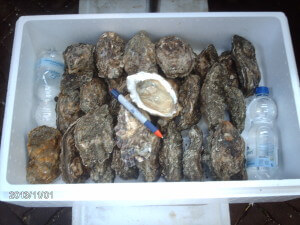 Tastiest alive
Tastiest alive
The Wild Wad Oysters can grow between 9 and 15 cm. the largest can even reach up to 35 cm. Taste depends on where the oyster grows. Raw taste is soft, fresh and salty. Beside the salt in the water also the nutrient and plankton is very important. By turn the oyster regularly, the texture of the meat will grow stronger.
The Wild Wad Oysters are hand-collected by traditional fishermen on the oysterbanks in the Wadden Sea. These are Pacific oyster (Crassostrea gigas), a species that is used around the world in aquaculture. In France this species is known as “Creuse”. These oysters were introduced to the Wadden Sea in the 1980s, after this they spread and oyster banks established themselves. At low tide, the oyster banks are accessible and the fishermen can collect the oysters. The oysters are then cleaned and packed on shore.
The genuine taste of the Wadden Sea
The Wadden Sea is an exceptional area. The salty water from the North Sea together with fresh water from the Rhine and Ems rivers flow between the sheltered coastal sea of the Wadden isles.
The abundant plankton is a food for mussels, cockles, winkles and oysters who live on and in the Wadden seabed. When it is low tide, birds on the mudflats eat cockles and mussels, while fishermen on the oyster banks collect the Wild Wad oysters. The oysters are meaty and contain the pure taste of the Wadden Sea: a saline sweetness, which is full and round.
Food from what the Wadden Sea mudflats provide
The small scale traditional fishery is as old as the Wadden Sea itself, but its future is vanishing.
Human interventions in the form of dikes and dams together with a changing environment are changing the mudflats. Artisanal coastal fishers therefore also have to adapt. Wild Wad Oysters have the natural taste of this beautiful nature reserve. Thanks to good environmental management and weekly sanitary checks, the health of this product is guaranteed. You are supporting the fishers by enjoying it.
Recognised local product, slow food presidium en UNESCO World Heritage
Oysters with the Waddengoud label are guaranteed to have been collected at wild oyster banks in the Wadden Sea and are fished and processed by strict rules. Wadden fishers who fish with traditional fishing gear and who are working to preserve their profession are recognized by Slow Food as a “Presidium”. This means that the fishers and their fishery a part is of the protected UNESCO World Heritage Site Wadden Sea.
Productinformation:
- Naam: Wilde Wadden Oester
- Eng: Wild Wad Oysters
- Lat: Crassostrea Gigas
- Condition: fresh and live product. Wild caught
- weight: 200 gr. – 1000 gr. p/piece
- Season: The whole year.
- Grow area: Waddensea
- Quota: 4000 – 5000 pieces per week
- Delivery: within 7 days..
- Casing: polystyrene boxes, incl icepackaging.7 – 8 kg per box

